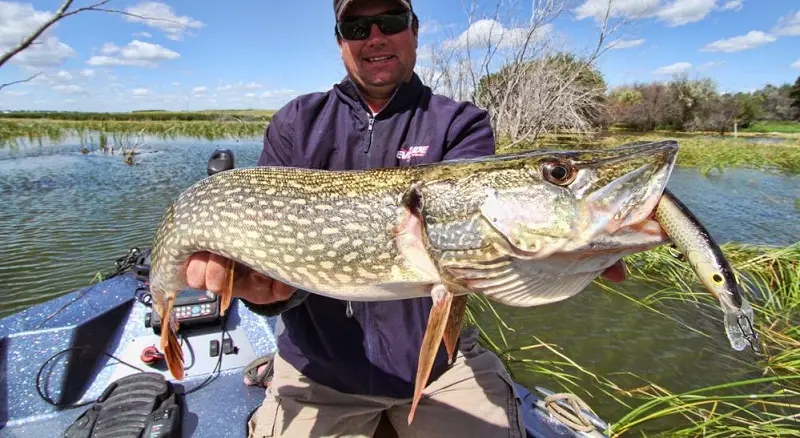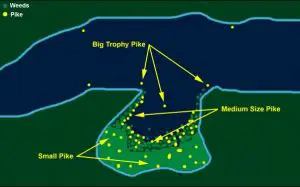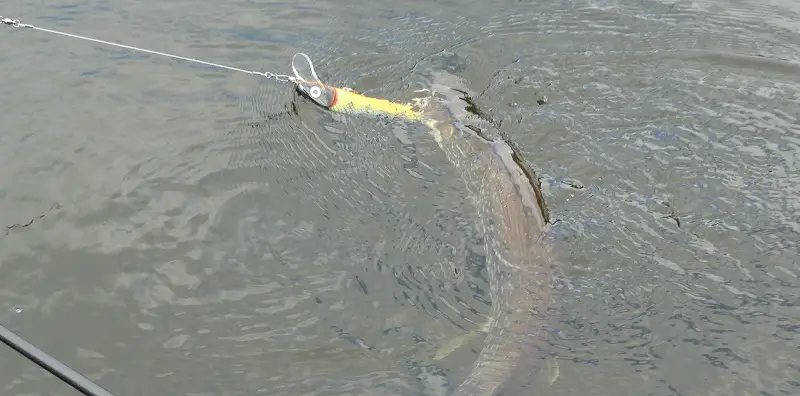
Northern Pike are among the most popular fish for anglers to catch, especially in the regions of Britain and Ontario.
The Northern Pike has a distinguishing appearance: they are quite large, on average about thirty inches long. They have a slender body and a distinctive, almost triangular-shaped head. They have a green or brown tint to their color and often have a coating of slime along their body which has a distinct smell to it.
One of the defining features of the pike is its needle-sharp teeth. Be very careful when handling pike, as they may try to take a bite out of you. Make sure you use a net and remove the hook with a set of pliers so you don’t put your fingers near its mouth.
Pike are quite aggressive and will attack almost anything, including bugs, frogs, smaller fish, and each other. They live in freshwater areas such as lakes and rivers, especially around rocky or weedy areas.
Our Tips
When to Fish for Northern Pike
If you’re going for the big trophy fish, the best time of year to go is during the late summer to mid-fall. During this time, it is possible to catch pike up to forty inches or longer. At this time of year, the fish will move from deeper waters which are starting to cool off, towards the shore, especially near weed beds, where they can wait to ambush prey. However, although you can catch some very large pike during this time frame, you might not experience catching a lot of fish.
If you’re looking for a quicker pace, but are okay with catching smaller pike, you will want to fish in the late spring to mid-summer time. It is at this time that there will be lots of pike very active. You are going to want to avoid the mistake of fishing in too shallow of water at this time. At this time, when the deeper parts of the lake are warmer, there will be lots of pike hunting for prey away from the shoreline.
Where to Find Northern Pike

You will find pike in lakes; the small and medium-sized ones will be found near patches of lily pads and reeds, where they feed on minnows and bugs. They like to hide in the weeds and ambush their prey.
If you’re looking for bigger pike, you’ll want to look further away from the weeds. The big pike don’t mess around with small minnows; they tend to hunt larger prey, such as walleyes. You’ll want to look for their prime hunting grounds to look for pike. This includes around shoals or rocky points. The best place to find them is near the mouths of streams or between islands.
Which Equipment is Best for Northern Pike
For the tough pike, you’re going to want to use a rod with a decent amount of backbone, as these fish will fight hard. Your rod should be about seven feet with medium-heavy action. A baitcasting reel is preferred, as it will provide the strength you need to reel your fish in.
Due to their aggressive feeding habits, pike will go after nearly any type of lure. If you want to attract some large trophy pike, you’re going to want to use some larger lures, which resemble the type of fish that pike hunt for. Some of the more popular types of lures are made by Daredevil or Rapala. Spoons are very popular to use. The wobbling and flashing of the spoon will attract the pike like crazy. This is especially true if you outfit your spoon with bait. If you’re going to use bait, minnows will be most effective.
However, keep in mind that the big pike aren’t going to waste their time chasing after small minnows. They’re used to chasing after larger walleyes. The most effective bait will be between six and eight inches long. It may be difficult to find stores that will sell bait of this size, so you might consider catching your own bait. Using small hooks and line, you can catch small suckers in freshwater streams. These fish aren’t too difficult to catch and are great for attracting the attention of pike.
Due to the ferocity and sharp teeth of pike, they have a tendency to bite clean through the line. For this reason, you’re going to want to make sure you use a heavy leader and strong line. Make sure you use monofilament or braided line to withstand the pike’s bite. Regular line will simply snap of, and you will lose both fish and lure.There are several types of leaders that are common to use when pike fishing.
Some fishermen like to use steel-coated leaders, as they are very strong, and are effective at preventing bite-throughs. However, their rigidity and toughness may dissuade pike from biting at all. There are a variety of leaders specially made for pike fishing, such as wire-wound and nylon-coated types which combine strength with flexibility that are great for keeping your line intact without scaring the fish off.
Techniques to Use when Fishing for Pike

Trolling
One of the most popular techniques used for pike fishing is trolling. If you have never heard of this, let me give you some idea of what it is. Trolling is the act of drawing your lure through the water, usually behind a moving boat. This has the additional benefit of setting up more than one rod at once (make sure you check with local regulations first though). The lure spins and weaves as it’s pulled behind the boat, giving it a swimming motion. This will attract the pike, as they love to go after a good fight. Try doing this along weed beds, as pike will most likely be hiding in the vegetation, waiting to ambush prey.
Lure “Slapping”
If you’re up for a little challenge, try this tactic out for size. When casting, an effective technique is to slap the water with your lure. This might be a little difficult to pull off, but once you start doing it right, it can be a lot of fun. To achieve this, cast your line up higher than you normally might. Right before your lure hits the water, about a couple of feet above the surface, swiftly pull your line towards you. If you do it right, the lure will make a slapping sound as it hits the water. The resonating sound will alert the pike and rouse them into feeding mode. Using this technique may require some practice, but if you manage to do it right you’ll be pleased with the result.
Dead Stick
Dead sticking is a technique often used in bass fishing, but it works well with pike too. When bass fishing, dead sticking is usually used with soft plastic lures, but when dead sticking for pike, try using a jerk bait. To do this, cast your line out to where you think your fish may be. Let your lure sink to the bottom, and wait about a minute. Give your rod a few jerks upwards, then reel in the slack. Repeat this process until you get a hit, or your lure comes back to you, in which case, give it another cast and try again.
Double Lure
Another trick is to set up a second lure to make it look like it’s a fish chasing your main lure. The pike will hate to see a competitor going after a potential meal, and will really rile them up. Old broken lures are perfect for this, as you’ll find a use for your worn-out gear. Setting up your old lure to create the illusion that it is chasing your bait will really get the pikes’ attention. Pike are voracious predators, and very competitive. Letting them believe that another fish is about to get the meal will make them angry and trigger their competitive spirit. They’ll try to snatch up your lure before the other fish can get it!
Play with the Bait
When fishing for pike, you’re going to want to let the fish play with your bait.
Pike are notorious for playing games with bait. A big pike may hit your line many times before taking the bait. In fact, there has been stories of fishermen catching and releasing the same pike multiple times, because they are so hungry they’ll keep hitting your line. You’ll want to just remain patient. If it hits your bait over and over, it will return. Pike have a large appetite and will be happy to keep feeding. Keep your pike’s attention by keeping your bait and lures moving. Remember that pike are active hunters. Nothing gets a pike motivated more than active, squirming prey. Applying a jigging motion will keep the pike enticed and returning, again and again, to check it out before it finally gets hooked.
Final Words
Hopefully, these tips and techniques help you with your northern pike fishing.
Pike are some of the most awarding fish to catch, due to their large size and aggressive feeding habits. Knowing the particular techniques needed to catch northern pike will really lead to a fulfilling fishing adventure.
